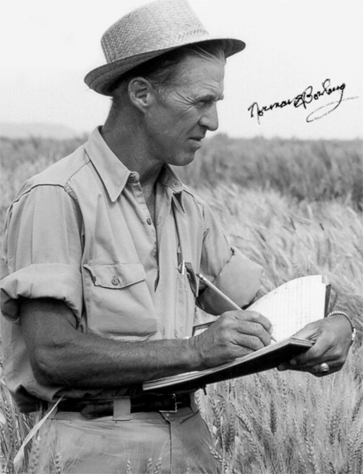The Father of Green Revolution has died at his home in Dallas, Texas on 12th Sept, last Saturday at the age of 95. If not for this legend, most of us would not have been here today. His efforts in increasing crop yields have saved hundreds of millions of lives around the world. It has been said the Borlaug saved more lives than any other person in history. For this he received the Nobel Peace Prize in 1970. And he is the only person to have won a Nobel in agriculture so far. Borlaug was also one of five people to have won the Presidential Medal of Freedom, and the Congressional Gold Medal, which is the highest US civilian medal.
In 1944, when many parts of developing countries were facing the threat of mass starvation due to rapid increase in population, Borlaug began his work at a project funded by Rockefeller Foundation in Mexico to increase wheat production. He successfully developed wheat with a sturdy, short stalk that could hold the high-yielding grain on top. He was also able to build in fungal resistance trait in this wheat against wheat stem rust. There wasn’t a short-cut in developing these varieties. Borlaug collected wheat strains from the around the world and started cross-breeding them. He worked with two crops a year, a summer crop in the low-quality, high-altitude soils near Mexico City, and a winter crop hundreds of miles to the north in the low-lying Yaqui Valley. This was done to speed up his research.
In five years, Borlaug was able to develop a variety that was resistant to rust , with higher yield and that was able to grow in both climate when given enough fertiliser and water. But because evolution favoured wheat strains with longer and slender stalks, the stalks tended to collapse when irrigated and this reduced the yield. After thousands of unsuccessful attempts to produce a dwarf variety, Borlaug encountered a Japanese dwarf variety. And finally after another thousands of attempts, in 1954 he successfully developed a short-stalked variety that was rust-resistant and high-yielding.
Due to this variety, Mexico was able to become a wheat exporter in the 1960s. In late 1960s, Borlaug, began his work in India and Pakistan. India was importing 10 million tonnes of wheat at that time. Thanks to Borlaug again, with the introduction of the dwarf variety of wheat, India too emerged as a wheat exporter and became self-sufficient. In Pakistan, wheat production increased from 4.6 million tonnes in 1965 to 8.4 million tonnes in 1970. In 1960, the world production of wheat was 692 million tonnes for a population of 2.2 billion. With the introduction of Borlaug’s techniques and varieties, in 1992, the world wheat production rose to 1.9 million tonnes for a population of 5.6 billion. This was achieved in spite of using only 1% more land.
Borlaug strongly felt that food scientists should be recognised with Nobel Prize, but this suggestion struck down by Nobel Prize which led him to establish the annual World Food Prize. Dr. M.S. Swaminathan was the first recipient of this. Most part of his lives was also spent on the argument over the social and environmental consequences of the Green Revolution.
Borlaug also became was a strong advocate of GM crops and often said that the critics of GM are elitists who are rich enough not to worry about where their next meal was coming from.
I am proud to mention here that Dr. Norman Borlaug was a Patron of ISAAA. His contribution and memories will never fade away and he will be truly missed.
By Mahaletchumy Arujanan



No comments:
Post a Comment